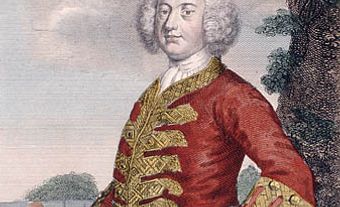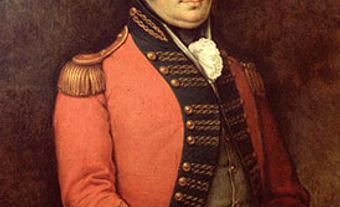William Claus, government official, militia officer, military figure in the War of 1812 (b at Williamsburg, near present-day Amsterdam, NY, 8 Sep 1765; d at Niagara, Ont, 11 Nov 1826). William Claus was born into a wealthy and prominent family. His maternal grandfather, Sir William Johnson, had large estates in the Mohawk valley and was the British government's superintendent of northern Aboriginal people. His father, Colonel Daniel Claus, held important positions in the Indian Department (see Indian). The outbreak of the American Revolution forced the family to flee to Québec in 1775. Claus later enlisted in the King's Royal Regiment of New York (commanded by his uncle, Sir John Johnson) and took part in several battles. He gained his lieutenancy and in 1787 obtained the same rank in a regular British regiment, the 60th Foot; in February 1795 he was promoted to captain.
Claus's uncle, Sir John, Superintendent General of Indian Affairs, tried repeatedly to obtain a position for Claus in the Indian Department and finally succeeded in having him named deputy superintendent of the Six Nations at Fort George. Claus reached his post in October 1796 and immediately became involved in the controversy over Joseph Brant's claim that the Six Nations of the Grand River had the right to sell portions of their land. Claus supported the government's refusal to recognize that claim. In 1800, Claus was appointed Deputy Superintendent General of Indian Affairs for Upper Canada. A rivalry for influence among the Six Nations on the Grand River developed between Claus and John Norton (Norton had been "adopted" by Joseph Brant and became a war chief for many of the Grand River warriors during the War of 1812).
Claus in the War of 1812
Claus was appointed lieutenant of the county of Oxford in 1802, which gave him authority to recommend militia officers. He was appointed colonel of the 1st Lincoln Militia in June 1812 and in July was put in command of the regulars and militia at Fort George and Queenston. On 13 October 1812, General Sheaffe ordered him to take charge at Fort George and to maintain the bombardment of Fort Niagara. In May 1813 Claus commanded the militia at Fort George, fighting in defence of the fort against the American invasion of 27 May, and he is thought to have been the last officer to leave before the invaders marched in. He joined the retreat to Burlington Heights and was part of the British force at Stoney Creek, although it appears he did not fight in the battle. In September General de Rottenburg sought the help of Claus and his followers to stem an increase in desertions along the Niagara. By 1814 Claus's rivalry with Norton was absorbing more and more of his attention.
Post-War Years
It was only after the war ended and Norton became less active in the Indian Department that Claus could escape the bitter rivalry. British policy toward Aboriginal people in Upper Canada changed dramatically in the post-war years. They were no longer needed as warriors; what the province required were farmers. Hence, Claus's role was to negotiate agreements with Aboriginal groups to extinguish their land titles, settle on reserves and adopt Christianity. His biographer believes that he "genuinely...cared about the native people" as they tried to adjust to a very different way of life. In his efforts to obtain adequate funding for their needs, he sometimes clashed with his superiors. Another historian writes that, as "trustee of the Grand River community's investments, ... Claus continued to abuse his office for personal profit."
Claus served in other roles such as justice of the peace (1803 onward) and member of the Legislative Council (from 1812). In 1816 he became an honorary member of the Executive Council, whose role was to advise the lieutenant governor, and in 1818 he became a full member. He was also a trustee for the Niagara public school and commissioner of customs for the Niagara District. He married and had 3 sons and 2 daughters who survived to adulthood. As a horticulturist, he was known for vegetable and flower gardens that were among the best in the region, and his orchards were renowned. The records he kept so carefully "provide excellent information on horticulture in Upper Canada." After he died, he was buried in Butler's Burying Ground outside Niagara [Niagara-on-the-Lake].

 Share on Facebook
Share on Facebook Share on X
Share on X Share by Email
Share by Email Share on Google Classroom
Share on Google Classroom


